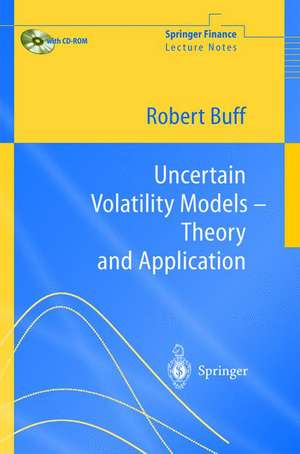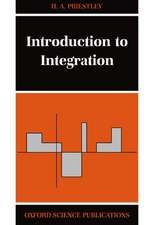Uncertain Volatility Models: Theory and Application: Springer Finance
Autor Robert Buffen Limba Engleză Paperback – 10 apr 2002
Din seria Springer Finance
- 13%
 Preț: 359.67 lei
Preț: 359.67 lei - 24%
 Preț: 703.47 lei
Preț: 703.47 lei - 18%
 Preț: 787.15 lei
Preț: 787.15 lei - 19%
 Preț: 501.62 lei
Preț: 501.62 lei - 24%
 Preț: 809.77 lei
Preț: 809.77 lei - 17%
 Preț: 361.15 lei
Preț: 361.15 lei - 24%
 Preț: 605.30 lei
Preț: 605.30 lei - 17%
 Preț: 398.82 lei
Preț: 398.82 lei - 15%
 Preț: 649.06 lei
Preț: 649.06 lei - 18%
 Preț: 937.37 lei
Preț: 937.37 lei - 15%
 Preț: 659.85 lei
Preț: 659.85 lei - 18%
 Preț: 801.17 lei
Preț: 801.17 lei -
 Preț: 387.75 lei
Preț: 387.75 lei - 18%
 Preț: 1108.36 lei
Preț: 1108.36 lei - 15%
 Preț: 651.19 lei
Preț: 651.19 lei - 15%
 Preț: 658.88 lei
Preț: 658.88 lei - 18%
 Preț: 1112.60 lei
Preț: 1112.60 lei - 18%
 Preț: 937.86 lei
Preț: 937.86 lei -
 Preț: 418.34 lei
Preț: 418.34 lei -
 Preț: 398.15 lei
Preț: 398.15 lei - 15%
 Preț: 597.01 lei
Preț: 597.01 lei - 15%
 Preț: 637.89 lei
Preț: 637.89 lei - 18%
 Preț: 939.62 lei
Preț: 939.62 lei - 15%
 Preț: 632.19 lei
Preț: 632.19 lei - 18%
 Preț: 737.26 lei
Preț: 737.26 lei -
 Preț: 385.84 lei
Preț: 385.84 lei - 18%
 Preț: 892.90 lei
Preț: 892.90 lei -
 Preț: 395.25 lei
Preț: 395.25 lei - 15%
 Preț: 497.45 lei
Preț: 497.45 lei - 15%
 Preț: 644.95 lei
Preț: 644.95 lei - 18%
 Preț: 1207.45 lei
Preț: 1207.45 lei - 18%
 Preț: 810.81 lei
Preț: 810.81 lei -
 Preț: 391.61 lei
Preț: 391.61 lei - 19%
 Preț: 506.25 lei
Preț: 506.25 lei - 18%
 Preț: 957.62 lei
Preț: 957.62 lei - 15%
 Preț: 503.37 lei
Preț: 503.37 lei - 15%
 Preț: 593.91 lei
Preț: 593.91 lei -
 Preț: 383.71 lei
Preț: 383.71 lei
Preț: 387.75 lei
Nou
Puncte Express: 582
Preț estimativ în valută:
74.19€ • 77.47$ • 61.41£
74.19€ • 77.47$ • 61.41£
Carte tipărită la comandă
Livrare economică 05-19 aprilie
Preluare comenzi: 021 569.72.76
Specificații
ISBN-13: 9783540426578
ISBN-10: 3540426574
Pagini: 256
Ilustrații: XII, 244 p. With online files/update.
Dimensiuni: 155 x 235 x 13 mm
Greutate: 0.41 kg
Ediția:Softcover reprint of the original 1st ed. 2002
Editura: Springer Berlin, Heidelberg
Colecția Springer
Seriile Springer Finance, Springer Finance Lecture Notes
Locul publicării:Berlin, Heidelberg, Germany
ISBN-10: 3540426574
Pagini: 256
Ilustrații: XII, 244 p. With online files/update.
Dimensiuni: 155 x 235 x 13 mm
Greutate: 0.41 kg
Ediția:Softcover reprint of the original 1st ed. 2002
Editura: Springer Berlin, Heidelberg
Colecția Springer
Seriile Springer Finance, Springer Finance Lecture Notes
Locul publicării:Berlin, Heidelberg, Germany
Public țintă
ResearchCuprins
1 Introduction.- I Computational Finance: Theory.- 2 Notation and Basic Definitions.- 3 Continuous Time Finance.- 4 Scenario-Based Evaluation and Uncertainty.- II Algorithms for Uncertain Volatility Models.- 5 A Lattice Framework.- 6 Algorithms for Vanilla Options.- 7 Algorithms for Barrier Options.- 8 Algorithms for American Options.- 9 Exotic Volatility Scenarios.- III Object-Oriented Implementation.- 10 The Architecture of Mtg.- 11 The Class Hierarchy of MtgLib-External.- 12 The Class Hierarchy of MtgLib-Internal.- 13 Extensions for Monte-Carlo Pricing and Calibration.- A The Network Application MtgClt/MtgSvr.- B The Scripting Language MtgScript.- C Mathematica Extensions.- References.
Recenzii
From the reviews:
MATHEMATICAL REVIEWS
"The book bridges theory and real-world problems in a clear and pragmatic fashion. It can be useful both for academics and professionals in the financial community."
"This book, which comes out of the author’s Ph.D. thesis, introduces uncertain volatility models. … The formal results are illustrated by many empirical examples. … The book bridges theory and real-world problems in a clear and pragmatic fashion. It can be useful both for academics and for professionals in the financial community." (Damir Filipovic, Mathematical Reviews, 2003 i)
"The book is devoted to the study of uncertain volatility models that evaluate option portfolios … . The author travels in this book the entire road from innovative mathematical finance to a working software system … . Practitioners and students who need to build analytic software libraries may benefit from reading this book … . This book is also for graduate students and researchers who wish to study advanced aspects of volatility risk in portfolios of vanilla and exotic options." (Anatoliy Swishchuk, Zentralblatt MATH, Vol. 1004 (4), 2003)
MATHEMATICAL REVIEWS
"The book bridges theory and real-world problems in a clear and pragmatic fashion. It can be useful both for academics and professionals in the financial community."
"This book, which comes out of the author’s Ph.D. thesis, introduces uncertain volatility models. … The formal results are illustrated by many empirical examples. … The book bridges theory and real-world problems in a clear and pragmatic fashion. It can be useful both for academics and for professionals in the financial community." (Damir Filipovic, Mathematical Reviews, 2003 i)
"The book is devoted to the study of uncertain volatility models that evaluate option portfolios … . The author travels in this book the entire road from innovative mathematical finance to a working software system … . Practitioners and students who need to build analytic software libraries may benefit from reading this book … . This book is also for graduate students and researchers who wish to study advanced aspects of volatility risk in portfolios of vanilla and exotic options." (Anatoliy Swishchuk, Zentralblatt MATH, Vol. 1004 (4), 2003)
Textul de pe ultima copertă
This book introduces Uncertain Volatility Models in mathematical finance. Uncertain Volatility Models evaluate option portfolios under worst- and best-case scenarios when the volatility coefficient of the pricing model cannot be determined exactly. The user defines subjective volatility constraints; within those constraints, extremal prices are computed. This book studies two types of constraints: volatility bands with upper and lower bounds, and shock scenarios with short periods of extreme volatility, but unknown timing. Uncertain Volatility Models are nonlinear. Worst- and best-case scenarios applied to isolated option positions do not always lead to the same extremal volatility. When applied to an options portfolio, a diversification effect reduces the overall exposure to volatility fluctuations within the subjective constraints. This book explores algorithmic issues that arise due to nonlinearity. Because Uncertain Volatility Models must be applied to option portfolios as a whole, they are difficult to implement on a computer if the portfolio contains barrier or American options. This book is for graduate students, researchers and practitioners who wish to study advanced aspects of volatility risk in portfolios of vanilla and exotic options.
Caracteristici
No other book does this Includes supplementary material: sn.pub/extras

















